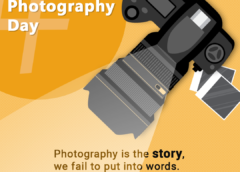WORLD PHOTOGRAPHY DAY
World Photography Day originates from the invention of the daguerreotype, a photographic processes developed by Louis Daguerre. On January 9, 1839 The French Academy of Sciences announced the daguerreotype process and a few months later, on August 19, 1839, the French government announced the invention as a gift free to the world.
Photography
Photography (derived from the Greek photos- for “light†and -graphos for “drawingâ€) is the art, science, and practice of creating durable images by recording light or other electromagnetic radiation, either chemically by means of a light-sensitive material such as photographic film, or electronically by means of an image sensor. Typically, a lens is used to focus the light reflected or emitted from objects into a real image on the light-sensitive surface inside a camera during a timed exposure. The result in an electronic image sensor is an electrical charge at each pixel, which is electronically processed and stored in a digital image file for subsequent display or processing.
The result in a photographic emulsion is an invisible latent image, which is later chemically developed into a visible image, either negative or positive depending on the purpose of the photographic material and the method of processing. A negative image on film is traditionally used to photographically create a positive image on a paper base, known as a print, either by using an enlarger or by contact printing.
The Inventor
Louis Jacques-Mandé Daguerre, had formed a business partnership with Nicéphore Niépce who died of a stroke (apoplexy of the brain), after which his son took his father’s place in the partnership. Niépce had started out experimenting with light sensitive materials and had made a contact print from a drawing, and then went on to successfully make the first record of an image in the camera obscura using materials that were light sensitive – the world’s first photograph. Niépce’s aim originally had been to find a method to reproduce prints and drawings for lithography.
Daguerre knew it would be difficult to collect patent royalties from the invention, and there had been an unsuccessful attempt by Niépce and Daguerre to issue stock so as to profit from the invention of the daguerreotype. The president of the French Academy of Science, the astronomer François Arago who sat as a Deputy in the French House of Deputies became enthusiastic about the invention and a committee was formed whereby Arago would present a bill in the House of Deputies and Gay-Lussac a similar bill in the Upper house of the French Parliament. Daguerre and Niépce’s son would each receive a life annuity, and the invention would be donated by the French government to the world.
The Daguerreotype process (also called Daguerreotypy) was the first practicable photographic process. Using the camera obscura (a drawing aid for artists that after the birth of photography became known as the photographic camera) a light tight plate holder was designed to hold a copper plate faced with a thin layer of silver. Prior to exposing the plate in the camera, the plate was made light sensitive by fumes from iodine crystals in a wooden box. After the exposure, mercury fumes would develop the image which was then fixed in a solution of common salt (sodium chloride) or of sodium thiosulphate. The plate could be toned in gold chloride.
1840–1841 Camerae obscurae and plates for Daguerreotype called “Grand Photographe†produced by Charles Chevalier (Musée des Arts et Métiers)
The camera obscura is a naturally occurring phenomenon. When a hole in the wall of a dark room faces onto a brightly lit scene – as, for example a dark cave on the edge of a sunlit valley, a picture of the scene outside can be projected upside down onto a sheet of paper or parchment held at a suitable distance from the hole inside the dark room. Early camerae obscurae were large dark rooms of this type (camera obscura is Latin for dark chamber). The system gives a brighter picture when the hole is replaced by a lens, and portable camerae obscurae were built with an internal mirror at 45 degrees to make the image upright. They are fitted with a ground glass viewing screen, and are used as a drawing aid by artists. Daguerre would have been familiar wth the camera obscura as a tool in his work as a theatrical scene painter, and had developed a visual public entertainment called the Diorama. By painting on both sides of a piece of white cloth, and illuminating the painting first from the front, and then from the back, an illusion of movement could be obtained to depict a train crash, or the erupting of a volcano. Dioramas were opened in towns in several countries.

Leave a Reply
You must be logged in to post a comment.